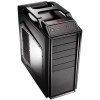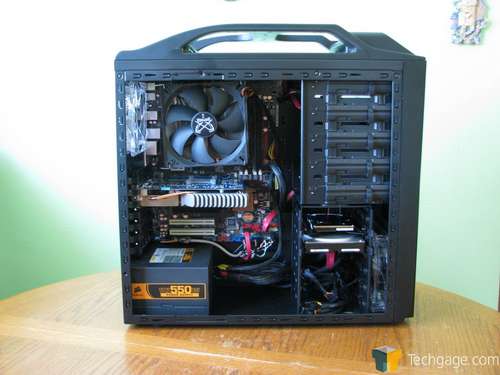- Qualcomm Launches Snapdragon 4 Gen 2 Mobile Platform
- AMD Launches Ryzen PRO 7000 Series Mobile & Desktop Platform
- Intel Launches Sleek Single-Slot Arc Pro A60 Workstation Graphics Card
- NVIDIA Announces Latest Ada Lovelace Additions: GeForce RTX 4060 Ti & RTX 4060
- Maxon Redshift With AMD Radeon GPU Rendering Support Now Available
Cooler Master Storm Scout Mid-Tower

Cooler Master impressed us greatly with their first “Storm” chassis, the Sniper, and we’re happy to report that their follow-up, the mid-tower Scout, is yet another winner. Like the Sniper, the Scout has features directly targeted towards LAN gamers, has great cooling abilities, runs quiet, and is set to be priced at an affordable $120 USD.
Page 2 – Installation and Testing
For my testing I used a new program called OCCT 3.0. Not only does this simple program push the CPU to the brink of a meltdown through the use of LINPACK testing for Intel processors, it also turns up the juice on your GPU. It automatically maintains graphs of temperatures throughout your testing. I highly recommend you try it out on your own for your testing needs. I always run all my tests 3 times and take an average just to weed out any erroneous results. My ambient temperature is kept at a near constant 68°F (20°C) year round as my test bed PC is in my basement. There are no fans or heat vents in the area of the test platform.
I use a static overclock and settings for all my testing. Stock testing is done with all settings in the motherboards BIOS to Auto. Overclocked testing is done by turning the CPU multiplier to 11x and manually setting the Vcore to 1.275v as well as enabling line load option. This results in a processor frequency of 3.67GHz with 1.25v Vcore as reported by CPU-Z in Windows. The video card is by nature of being fanless does not over clock enough to change the results so it remains at stock speeds through all testing. This is by no means the absolute maximum clocks, they are just meant to add extra stress to the components to simulate a potential overclock obtainable by most people.
Our system for testing is as follows:
|
Component
|
Model
|
| Processor |
Intel Core 2 Extreme QX9650 – Quad-Core, 3.0GHz, 1.30v
|
| Motherboard |
ASUS P5Q PRO – P45-based
|
| Memory | |
| Graphics | |
| Audio |
On-Board Audio
|
| Storage |
Hitachi 160GB
|
| CPU Cooler | |
| Power Supply | |
| Et cetera |
As I expected, the build here was very straight-forward. There are lots of notches on the backside of the motherboard tray for attaching zip ties, so you can easily secure many cables. There is less room than I prefer behind the tray for this purpose, however. The CPU power cable has to be run inside the motherboard area as there is no provision for running it behind the tray. Cable management is a bit of a challenge, but there is room to tuck everything away as long as you take your time.
After everything is installed and buttoned up it’s time to sit back and enjoy the fruit of your labor. While I use a relatively short graphics card for my testing you don’t have to worry since there is a full 10.5″ between the backside of the case and the backside of the HDD cage. You can also see just how nice everything looks with the fully painted interior. I for one am very partial to a nice black interior. For a chassis with such a small footprint you sure get a lot of room to play with.
After running all my tests here are the results:

We see by the results that the cooling capabilities of the Scout are right up there with some of the best. I was very satisfied especially considering the choice of nearly-silent fans by Cooler Master. I had the test subject within 3′ of me during all testing and I caught myself 3 times looking down at it making sure it was even running. Definitely a very stealthy design, especially when you turn off the LED’s.
Support our efforts! With ad revenue at an all-time low for written websites, we're relying more than ever on reader support to help us continue putting so much effort into this type of content. You can support us by becoming a Patron, or by using our Amazon shopping affiliate links listed through our articles. Thanks for your support!






